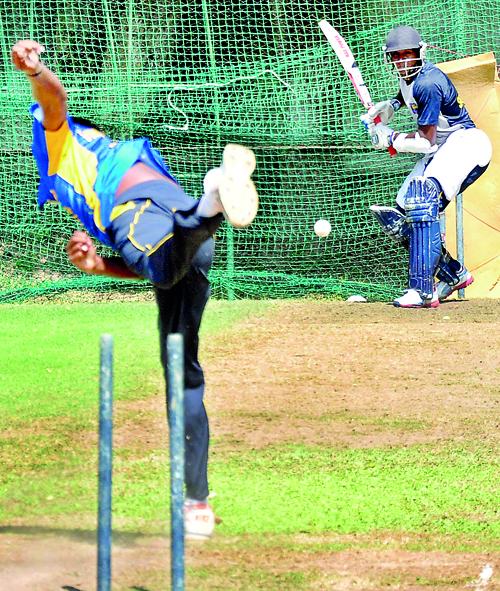Lanka’s Cricket wandering on powder keg
It’s a funny world. Ten different people see the same peak of a mountain in ten different angles.
It’s no different with cricket. There are hundreds of people who are involved with the game at different levels and all of them seem to be professing about the upliftment of the sport in the country. Yet, what really occurs in practice is different.
 For instance, take the majority of the dudes that scurry along the corridors of the Sri Lanka Cricket Headquarters at Maitland Place. Most of them masquerade as important people and their poker faces are generally embedded with VVIP looks. But in reality they are there looking out for their pound of flesh and care less for cricket if it is played on turf, matting or on concrete as long as their share of the booty comes along.
For instance, take the majority of the dudes that scurry along the corridors of the Sri Lanka Cricket Headquarters at Maitland Place. Most of them masquerade as important people and their poker faces are generally embedded with VVIP looks. But in reality they are there looking out for their pound of flesh and care less for cricket if it is played on turf, matting or on concrete as long as their share of the booty comes along.
The ‘big divide’ of the money for development of clubs nearly divided the entire cricket administrational structure into the microscopic fragments. Luckily the all-seeing and all-knowing sports minister, Mahindananda Aluthgamage, intervened and quelled the storm or it seemed to be so. He even went to the extent of finding a scapegoat in SLC CEO Ashley de Silva and hung all the sins of the in-fighting upon that poor man’s shoulders. Once again Huckleberry Finn is rowing the boat oblivious of the huge piece of wood that is missing from the bottom. Not bothered by the prevailing status quo, we on our own decided to go into the root and pick some brains of people who do the bulk of work to sustain the game in the country and asked them in which manner this distribution of funds would help uplift the game’s local standards.
This lot wished to remain behind the curtain for the plain and simple reason of not becoming the next target. Yet, when asked the right questions, they spoke and spoke with passion because they seemed to know where cricket’s ozone layer is damaged and when the seas of catastrophe would begin to rise.
First they came out with a very salient factor. They said Sri Lanka has several hubs of cricket, but, the game is largely concentrated in Colombo. They pointed out that in Galle there is no Premier League team that is involved with the game. The situation remains the same in the other cities such as Kandy, Kurunegala, Anuradhapura and Matara. The equation did not stop at that point. They pointed out that the only decent turfs outside the main city of Colombo — the Galle Stadium, the Pallekelle Stadium and the Hambantota Stadium — are used exclusively for international matches. In a lighter vein one said that a lad from Sri Lanka making his debut in an International at the Pallekelle Stadium and a lad who have travelled to Sri Lanka for the first time to take part in a cricket series would be playing in equally alien conditions.
Another argument was — why should money be allocated to a club like Galle CC as the Galle Stadium is not used for local cricket. They have no Premier League team although SLC President Jayantha Dharmadasa is also the president of that club. The ground is sustained by Sri Lanka Cricket. Then what infrastructure development could go for Galle CC. How are these funds going to be utilised?
Adding more to the argument, another expert said the SLC’s focus on development is all hazy and has no direction. He argued that building side wickets all over and distributing goody bags to schools are not going to change the face of the game. In the same vein posting coaches in every nook and cranny also does not serve the real purpose. What they argue is that school cricket has the strongest base in the system and that is a system that could work without remote control. The reason: It has a deep rooted base and in most instances it almost runs on its own. Even the Sri Lanka Schools Cricket Association (SLSCA) nourishes on the system and not vice-versa.
We were struck by surprise when we heard that the real problems lay in the post-school run, which comes under the purview of Sri Lanka Cricket.
The experts claim that the domestic system in the country had not turned professional, in spite of real professionalism has entered the higher echelons of the game.
For instance, once you become the Sangakkaras, the Jayawardenas and the Malingas, you are on a different pedestal in the income category. Yet, to sustain a system of producing the real professionals is still at an archaic stage. The danger is so real that it may reach a breaking point even without the game realising it.
The experts said they had no qualms about the income levels of Sangakkaras. It portrays the levels that one could achieve by engaging in the game professionally. That is a goal that every budding cricketer could aspire to.
Yet, there is another reality that is in the knowhow of every cricketer who play the game at Premier level.
Once you become a national cricketer and gets heavily involved in that calendar, you are physically out of the club rounds. The international calendar is so heavy that the national cricketers hardly have the time to spend a few hours with their families. Yet, to sustain the game at home and find the necessary feeder to the national grid, the prevailing club system has to survive.
How? This is the golden question. In this professional environment at least the Premier League Cricketers have to be paid for their contribution to the national cause. In countries like England the cricketers who are involved in the county circuit are paid and they do lead a respectable life.
In the world circuit, the Lankan cricket is second to none. In each segment of the game they are either among the top three or above the middle level. In an ideal environment of this nature Sri Lanka Cricket which pays the clubs their upkeep and then back it by huge grants, the players should be leading a respectable life.
Ironically it is a sad situation. The Lankan Premier Level cricketers are paid Rs. 4,500 a day for playing a match. Taking the three month pocket of playing and if they engaged in 50 days of active cricket, a Premier League cricketers makes a maximum of Rs. 225,000 for the season. Remember as a professional you have to sustain yourself through the year with that stipend. Even though it is three months of cricket, there is a lot more time that is consumed for training and other matters that go along with the game. This means they earn an average of Rs. 18,750 a month – a salary less than that of a normal office assistant.
This is where the anomaly rests. It is against this backdrop that around a hundred cricketers leave our shores to play overseas year in year out. These lads who are contracted to play in countries like Australia, England and Canada as overseas professionals are the cream of the local club circuit. Even for playing in those lowly tournaments they are paid around Rs. 1-2 million a year. Yet, the catch is when around one hundred of the top players travel overseas to play in substandard tournaments abroad, our own Premier League tournament suffers. When the country’s second level players are absent, automatically it is the third level of players who take part in the local Premier League tournament.
Still the Lankan administrators have not felt the repercussions of letting the local Premier League getting washed down the gully. The threat is real and this is a live situation.
This is not like wooing the stakeholders with the fat grant to get their votes. This is a situation where if meaningful solutions are not found, the SLC would feel the real heat once the Sangakkaras and the Jayawardenas are gone.


